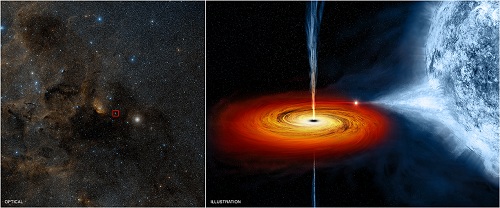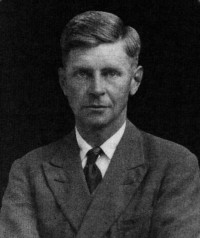Centauri Dreams
Imagining and Planning Interstellar Exploration
Terraforming: Enter the ‘Shell World’
If we ever achieve manned missions to the stars, one of the assumptions is that we will find planets much like Earth that we might live on and colonize. But what if the assumption is flawed? There are surely many Earth analogues in the Milky Way, but we don’t know how widely they are spaced, and a near-miss isn’t necessarily helpful, as both Mars and Venus attest. People like Robert Zubrin continue to advocate terraforming as a solution for Mars, and it may well happen one day, but supposing we get to another star, would we have the moral right to terraform a world with living creatures on it, even if they didn’t meet our criteria for intelligence?
Robert Kennedy (The Ultimax Group), working with colleagues Kenneth Roy and David Fields, has been pondering these issues and went through a possible solution at the recent Tennessee Valley Interstellar Workshop in Oak Ridge. If we stop worrying about Earth analogues, a range of interesting possibilities open up, as our own Solar System illustrates. We have small planets like Mars, along with what may be a huge number of dwarf planets. We also have moons in a wide range of sizes around the gas giants. Suppose we could transform such worlds by building a spherical shell of matter around them, totally enclosing an atmosphere and living ecosystem?
Beyond the Habitable Zone
The idea seems outrageous, but Centauri Dreams readers are familiar with even more gigantic concepts like Dyson shells, engineering on levels that would require a Solar System-wide infrastructure and a Kardashev Type II-level civilization to build. If we extrapolate advancing technologies that can do gigantic things, we can consider creating an Earth-like environment (in most ways) under a shell that protects the inhabitants from radiation and provides a self-enclosed ecology. The question of a ‘habitable zone’ would disappear because artificial lighting and temperature control would be built in, and the wild card would be gravity, which would depend on which bodies were selected for enclosure. Most would offer gravity only a fraction that of Earth’s.
Kennedy and team wrote a paper for JBIS in 2009 that lays all this out. Working the math on spherical shells, they ponder the fact that if the objective is to contain a 14.7 psi Earth-normal atmosphere, such a shell would experience the same kind of pressure-induced tension found in a balloon. Assume one atmosphere of pressure at the underside of the shell and vacuum above it, and it is possible to choose a shell thickness so that the compressive stress of gravity cancels out the atmosphere-induced tensile stress in the shell. A shell made completely of steel, for example, built to enclose a world 20 kilometers above its surface, would need to be 1.31 meters thick if enclosing the Earth, and 8.05 meters thick if enclosing the Moon.
Moreover, the shell mass used is there simply to create compressive force — opposing the pressure of the atmosphere within the shell — and can be no more than dead weight. The authors figure that enclosing the Earth’s Moon could be done with no more than a 1-meter thick layer of steel if it incorporated 62 meters of regolith on top of it, with open-ended combinations of steel, ice, dirt and rock possible for the job:
It is not actually necessary to use a metal such as iron or steel. Stony materials such as concrete can handle a lot of compression. A strong fabric material that is airtight and in slight tension could be used to support the mass of the shell, which could be mainly rocks and dirt.
The authors contend that a shell with mass equally distributed across the surface of the shell will be stable with respect to the more massive body at the center of the shell:
If the central mass is displaced a given distance inside the shell, gravity will act to restore the shell’s original position with respect to that body. Such is not true for a ring. If there were no way to damp the movement, the shell would oscillate back and forth. A viscous atmosphere will tend to dampen oscillations until the mass center is once again congruent with the center of the shell.
The Riches of Ceres
Now consider the asteroid Ceres. Here the shell, depending on which mass estimate for Ceres we choose, would have to range (if made of steel) from 45.2 to 90.4 meters in thickness — this is the amount of mass that would be necessary to hold an Earth-normal atmosphere. This is one thick covering, providing enough shielding to survive a nearby supernova. Assume you have a terraformed Ceres that is half ocean and you wind up with enough dry land area to approximate the area of Indonesia, on a world where gravity is 1.5 percent that of Earth. Could a human colony survive in conditions of micro-gravity? At this point we simply don’t know the answer.
But think about the scenario for a moment. In an enclosed Ceres, climate is a design variable and lighting can be adjusted to approximate whatever day/night cycle the occupants desire. Imagine the underside of the shell as the urban area, a place where residents live in housing that overlooks the spectacular vista of the interior, which could be maintained as farmland or a nature preserve filled with whatever species the designers choose to introduce. With normal atmospheric pressures and light gravity, human-powered flight would always be an option. The outside of the shell would be devoted to heavy industry for manufacturing and power plants.
Taken to an extreme, we get this:
… the subterranean zones of small celestial bodies would offer vast – virtually unlimited – cubic for support functions and resource extraction. Consider that the interior of Ceres – half a billion cubic kilometers – could contain almost exactly the same working volume as a world-spanning city which packed the entire surface of Earth, oceans included, with billions of 1 km high skyscrapers, each the rival of Burj Dubai. In the light gravity of Ceres, every bit of that volume would be easily reachable and cheaply exploitable, unlike the deep wells and mines of Earth. A shell world might well be the richest planet in its solar system, once the huge cost of englobement was paid off.
Building for Safety (and Aesthetics)
Numerous dangers could beset a shell world, including many that already threaten our planet, such as the impact of large asteroids, but we could avoid some problems — volcanoes and earthquakes spring to mind — if we choose or build worlds without plate tectonics, and issues like solar flares would have little effect given the shielding the shell world’s inhabitants could rely on. A rupture in the shell would be a hazard, but a small shell world like Ceres would have a shallower gravity well than Earth and be less likely to draw in an asteroid. Moreover, any shell world would include the kind of planetary defense systems that a civilization capable of building the shell in the first place would be able to deploy. Shell maintenance, safety and improvement would doubtless be an ongoing project.
The paper works through one possible construction scenario involving the Moon and considers the massive amounts of energy required to move the needed terraforming materials (roughly one quadrillion tons), obviously requiring huge advances in energy production and space transportation. But it’s a fascinating vista, one that sees the creation of hanging cities on the underside of a shell that represents an area equal to four times the area of the United States. The surface of the re-made Moon can be tuned up to be as Earth-like as we choose to make it, the entire project taking hundreds and more likely thousands of years to see to completion.
The presence of hanging cities will diminish the required surface loading by inert material. Lighting would be artificial, with solar energy (assuming the shell world is near a star) powering up the lights, or power plants on the surface of the shell doing the job if the world were built in deep space. The paper argues that shell worlds all the way out to the Kuiper Belt could have an Earth-like insolation, ecology and diurnal cycle. And imagine this:
Existing electro-luminescent displays (ELD) only provide about 1-2 W/m2 of radiant energy in various colors from red to blue-green, but their state of the art (brightness, efficiency, cost) is rapidly advancing… Since ELD materials are presently available in all three primary colors and can be subdivided into addressable segments, we can imagine a pixelated ceiling of video wallpaper simulating the natural sky of Earth (clouds, sunsets, stars, etc.) or generating any arbitrary scene. The postindustrial motto “everything is media” means art can reach its fullest expression in the canvas of a shell world.
If we do become the Type II civilization capable of building such structures, we’ve not only opened up numerous worlds within our own system for colonization, but have also gained the experience needed for constructing stable generation ships for long-duration interstellar flight. And because shell worlds could be located anywhere a suitable moon or planet is found, we should consider the possibility that alien civilizations may already have constructed such worlds around red dwarf stars or even brown dwarfs, which may outnumber all other kinds of stars. The traditional concept of a habitable zone may not be the marker we’ve always assumed it to be, with prospects for SETI extending to worlds that would not before now have gained our attention.
The paper is Roy, Kennedy and Fields, “Shell Worlds: An Approach to Terraforming Moons, Small Planets and Plutoids,” JBIS Vol. 62 (2009), pp. 32-38. If you’re a science fiction writer in search of a setting, you must read this paper. I’ll also let everyone know when the Oak Ridge presentations become available online so you can see Robert Kennedy’s talk and slides.

Interstellar Flight: Equations and Art
Les Johnson (MSFC) always says that the coolest job title he ever had in his long career at NASA was Manager of Interstellar Propulsion Research. Think about it — if going to the stars is your passion and you have a title like that, you must feel that you have really arrived. These days he goes by the more prosaic title of Deputy Manager for the Advanced Concepts Office at Marshall Space Flight Center in Huntsville, but as the recent interstellar workshop in Oak Ridge demonstrated, he’s also ranging widely on his own as conference organizer, author and science fiction aficionado. His presentation in Oak Ridge was designed to jump start the conference with a survey of the problems of interstellar flight and the long list of possible propulsion solutions.
The Interstellar Conundrum
The problems are clear enough. Think of the distance between the Earth and the Sun (about 150 million kilometers). That’s 1 astronomical unit (AU). Shrink that distance to one foot and imagine the Solar System, with Neptune 30 feet out and so on. On that scale, the distance to the Alpha Centauri system is 47 miles. Moving at 17 km/sec, Voyager 1 would take 74,000 years to make the Centauri journey (if it were pointed in that direction in the first place, which it is not). Les was part of the Interstellar Probe Science and Technology Definition Team that aimed at designing a spacecraft that could reach the heliopause, and at this point in our technological evolution (this was back in the 1990s), it was clear that three propulsion options were possible: A chemical rocket with gravitational slingshots at both the Sun and Jupiter, solar sails, or nuclear electric.
Let’s pause on the latter. Electric propulsion, which uses electrical energy to heat and eject the propellant, offers much lower thrust levels than chemical propulsion, but it is ten times more efficient per pound of fuel. A mission to the outer system would require a nuclear power source operating at high power, but the technology is workable and in Les’ opinion could deliver a mission to 200 AU within 20 years of launch. Solar sail options are likewise no longer theoretical, and Les pointed out that NASA has selected L’Garde to work on a sail a bit less than 80 meters to the side that is to become the agency’s first deep space sail experiment in about three years.
From nuclear pulse propulsion (Project Orion, the size of an aircraft carrier, would present serious problems in terms of in-space assembly) to nuclear fusion and antimatter-catalyzed fusion, a variety of nuclear concepts have been considered, including the British Interplanetary Society’s Project Daedalus and the ongoing Project Icarus studies. Antimatter remains an elusive goal. We would need antimatter production of just kilograms per year to drive a true interstellar mission (compare this to tens of thousands of tons of helium-3 and other fuels needed for a Daedalus), but our current antimatter production is mere nanograms per year.
The Q&A session that followed Les’ talk brought a response to his contention that fission was not practicable for interstellar travel, noting that staged fission rockets might be able to reach 2 percent of lightspeed. If so, that does change the picture somewhat, and if anyone has a reference to a paper on staged fission concepts, I’d like to read more about this. Another interesting note: Les’ book Going Interstellar, edited with science fiction writer Jack McDevitt, is coming out from Baen some time in 2012. This is a collection of essays and fiction, and it was great to hear that the publisher intends to bring out a teacher’s guide to get these ideas to high school students. We need to energize that next generation.
Pushing into the Artistic Frontier
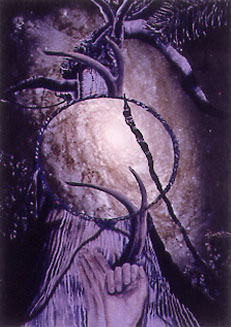
C Bangs is a Brooklyn-based artist whose work draws on a vision of man’s future in space. I use the term ‘vision’ with care, because I find her work laden with mythic echoes of our species’ past even as it points to a cosmic destiny that we seem impelled by our nature to strive for. I’ll add this: My own background as a medievalist left me with a fascination for illuminated manuscripts like the Lindisfarne Gospels and the Icelandic Flateyjarbók. Some of C’s work reminds me of ancient manuscript designs even as it draws on cutting-edge physics and astronomy, subjects she has illustrated so well in her collaboration with her husband Greg Matloff. If you page through a book like Solar Sails or Paradise Regained, you’ll see how her work re-states the scientific themes with archetypal resonances that take the reader into the realm of the transcendent.
Image: Green Man & NGC #4414. Credit: C Bangs.
The Paradise Regained book is particularly to the point here, because as C told the audience in Oak Ridge, she has long been fascinated with the Gaia Hypothesis, the concept that the Earth as a whole is a cooperative system that maintains conditions for its own survival. You can wed this deep interest in interlocking systems with a love of landscape that was surely nurtured by trips to Puerto Rico, where her father was teaching. One of these trips led to a tour of the great Arecibo dish, an experience that was both majestic and transformative. From then on, cosmology would weave into mythology as the basis for her vision. Her work for NASA includes a holographic coating technology that could enable 3-D images to accompany deep space missions (a set of her holographic work is housed at Marshall Space Flight Center).
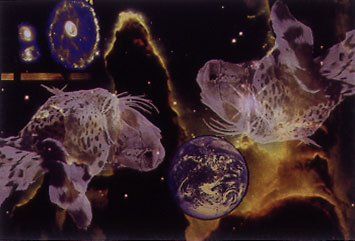
What struck me as C showed images of her work in Oak Ridge was the sense of optimism they contained. If she explores human consciousness through archetypes, she also insists on a positive response to the cosmos and an engagement with cutting-edge ideas. It’s no surprise that interstellar studies champion Robert Forward was a key figure in securing her early funding from NASA, and her continuing work with Greg has ensured that she keeps current with the interstellar community. Optimism may grow naturally out of that engagement, the idea being that without a frontier to explore, the problems of this planet can seem overwhelming, leading to a cynical, defeatist kind of art that is worlds away from what C expresses. Our problems are indeed huge, but space offers solutions to our resource crisis and feeds our need for exploration, the latter a deep-seated drive so well captured in C’s eloquent imaginings.
Image: Leopard Ceremony & Eagle Nebula. Credit: C Bangs.
Project Icarus: Pushing Designs to the Edge
People sometimes say that Project Icarus has a strange name, given that Icarus was a mythological figure who flew too close to the Sun and thus met his doom. But Icarus is also a logical name for the project that would follow up the 1970s-era Project Daedalus, which had been the first detailed design study of a starship ever made. After all, Icarus was the son of Daedalus, and as Richard Obousy pointed out in his presentation in Oak Ridge, the idea is that Icarus was a pioneer who pushed his technology to its limits to reveal its hidden flaws. Project Icarus aspires to do the same, to push a fusion design hard to uncover hidden problems, and determine just how much we have advanced since the heady days of Project Daedalus.

Now Richard Obousy is as engaging a proponent of interstellar flight as one could meet, and we enjoyed a lengthy dinner conversation after the day’s sessions were over. Every now and then I talk in these pages about teaching tools, the kind of comparisons that help us understand things like interstellar distances. Rich had one for me — Look at a map of the United States and imagine that the Earth is in New York City, while the Alpha Centauri stars are in Los Angeles. With that scale in mind, realize that our Voyagers, now entering the heliopause, would be roughly 1 mile along the route to LA. What we need to do, as Rich told the audience during his talk, is to increase velocity by a factor of about a thousand, to make missions consistent with human lifespans. Icarus chooses fusion as the best way to liberate the energies needed for that.
Image: Project Icarus arriving at a destination system. Credit: Adrian Mann.
The Project Icarus playbook is a thing to behold, with twenty different research areas under active investigation, everything from primary propulsion and fuel to power systems, communications, computing, vehicle assembly, risk and repair. Each of these modules has a lead and each lead has a team dedicated to solving the challenges of his or her subject. The purpose is not to build a starship — we’re a bit ahead of the curve for that — but to motivate a new generation of scientists to become involved in interstellar studies, to generate interest in precursor missions, to explore credible design concepts and assess the maturity of fusion.
The 100 Year Starship Study DARPA has funded will be making an award of $500,000 to the team it chooses to advance interstellar ideas in coming years — both the Icarus team (operating as Icarus Interstellar) and the Tau Zero Foundation have submitted proposals, along with a number of other organizations. We won’t know who wins the grant for a few months yet, but ponder the overall ideas. As Obousy told the audience in Oak Ridge, the average lifespan of a company in the United States is 13 years. What DARPA wants to do is provide seed money for an organization that will last for centuries. That in itself is perhaps a bigger challenge than building a starship. It involves an attempt to find the next Google, the next Apple, and to so craft the organization that it can survive economic ups and downs and changes in intellectual fashion.
Can it be done? The DARPA award-winner will make the effort, one that Centauri Dreams heartily applauds because it requires long-term thinking pushed to its limits, and shrewd marshaling of existing resources. Interstellar studies is an exciting place to be. We’ll talk on Monday about another exciting concept called ‘shell worlds’ that I learned about in Oak Ridge, and discover why little Ceres may one day be the richest world in the Solar System.

Interstellar Workshop in Tennessee
I’m just back from the Tennessee Valley Interstellar Workshop in Oak Ridge, having made it through the Smokies on a rainy, chilly night that saw fog along the ridges and often down in the valleys. It was a haunting drive in ways, the low ceilings making for slow driving and the sense of being surrounded by unseen peaks and deep gorges that were always just out of view. I had hoped to meet with Les Johnson and Robert Kennedy at the latter’s house for the pre-conference festivities, but arrived too late and worn out to do anything but get to sleep.
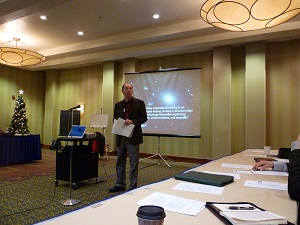
The workshop was an intense, one-day affair (a good thing I got that sleep!) that started at 8:00 the next day and concluded about 10:40 that night, and judging from the discussion at the end, it will become a regular event. It was great to see old friends. Les and I last talked at Aosta two years ago. Claudio Maccone had come from Italy and would be lecturing at Oak Ridge National Laboratory on the Karhunen-Loève transform the following day (search this site under ‘KLT’ to get the rundown on the possible uses of the transform in SETI, although SETI was not, presumably, ORNL’s chief interest in the subject). Al Jackson was in from Texas, as was Richard Obousy, and Greg Matloff and C Bangs had come down from Brooklyn.
Image: Les Johnson introducing the workshop.
The Tennessee workshop grew out of conversations last summer at the Aosta conference between Les and Claudio, allowing for a schedule that made an excellent fit for Claudio’s US trip — he leaves Oak Ridge today (Thursday) for Stanford (he’ll be having meetings at the SLAC National Accelerator Laboratory and will later be going to the SETI Institute). At the workshop, he discussed the gravitational lensing precursor mission concept called FOCAL that he has championed as a precursor to a true interstellar mission. 550 AU is one-half of a light week, 3.17 light days out, a useful distance at which to test a variety of interstellar technologies.
Communications Between the Stars
Claudio is pointing out that a model of the ‘naked Sun’ that derives 550 AU as the gravitational lensing distance doesn’t take into account solar corona effects that can distort imaging and communications, and the whole point of the mission is to use gravitational lensing to study what is on the other side of the Sun — to use the lensing phenomenon and a careful choice of departure directions for astronomical and perhaps SETI work. 1000 AU proves to be a better distance than 550 AU because of the coronal problem, and it’s interesting to note that the TAU Mission designed at JPL by the Meinels, a husband and wife team working in the 1980s, aimed at 1000 AU as well, although the Meinels had no knowledge of the gravitational lens.
TAU would have been flown using nuclear electric propulsion, and would have taken approximately 50 years to reach 1000 AU for studies of the heliosphere and the nearby interstellar medium, as well as improved parallax measurements of nearby stars. A true FOCAL mission like Maccone is proposing would be able to exploit the Solar lens for communications, allowing low bit error rates (BER) that conventional communications methods cannot touch. Thus we have the potential for communicating with an interstellar probe through a lensing mission that serves as a relay — in fact, you can get 8 light years out using a FOCAL relay before you show significant BER loss. And if you go into the deep future, the possibility of exploiting a similar lens relay around another star could allow the beginning of an ‘interstellar internet.’
And here’s an interesting point that came up in the discussions: Carl Sagan had hypothesized that gravitational lensing might be responsible for at least some of the thirty or so anomalous SETI signals that have never repeated (the famous WOW signal is the classic case in point). A non-repeating signal like this is conceivably the result of a low-powered transmitter occasionally having its gain boosted enormously by stellar focusing, all of this by sheer chance, so that what we pick up is simply a strong but unrepeated signal that tantalizes us as evidence for extraterrestrial technology. It’s an intriguing thought, but we have to fly a FOCAL mission at some point to find out whether the perceived benefits of the Solar lens are in fact exploitable. A FOCAL mission using tethered antennae inscribing Archimedean spirals to boost receiving capability is a project that might be flown using nuclear electric or solar sail technologies to investigate this.
Solar Sails Missions and Materials
Of course, with solar sails you start thinking about materials and how to deal with extraordinarily thin films. But as Greg Matloff pointed out, we’re coming off a banner year for solar sailing, with the launch of the Japanese IKAROS mission and, later, NASA’s NanoSail-D. IKAROS has been a stunning success, deployed as part of an interplanetary mission and able to demonstrate not just propulsion by sunlight but attitude control. Matloff pointed out that the hyper-thin solar panels deployed on the sail are continuing to work perfectly after a year, and their success may lead, eventually, to the Japanese launch of a solar power satellite that would explore options other than nuclear for meeting the nation’s intense power needs. What happened at Fukushima just underlines the need for space-based research on alternative power technologies. In any case, JAXA is on course for a sail-based mission to Jupiter later in the decade.

As to materials, beryllium has long been studied for sail use in inflatable, hollow-body sail concepts that Greg has explored in books like Deep Space Probes (Springer 2nd edition, 2005). One problem with it is that beryllium is a toxic poison, with all that implies for care in handling, but we do know that in the realm of high temperature metals studies, beryllium is a clear candidate. Graphene, though, gives you the best performance — in fact, Greg noted that graphene coupled with a close Solar pass could reduce trip time to Alpha Centauri to about 1000 years, about as fast a journey as it’s possible to make with a solar sail unaided by laser or microwave beaming.
Image: Greg Matloff runs through the promise, and the problems, of solar sailing.
We’re still talking futuristic concepts, given the fabulous cost of graphene today, and as far as laser or maser beamed sail concepts, we have issues like pointing and aiming. Matloff pointed out that we could not achieve the kind of tightly focused beam of sufficient power needed to fly such missions today. Laser technologies cost more than microwave, but are easier to collimate — the longer wavelength makes keeping the beam tight more of a challenge for the latter. Imagine the pointing and aiming problems involved in a concept like Robert Forward’s mission to Epsilon Eridani, where you have to deliver a beam to a sail that separates in Epsilon Eridani space to provide a deceleration option for the incoming spacecraft.
There’s much more to talk about but I’m running out of time this morning, so I’ll extend the Tennessee Valley Interstellar Workshop into tomorrow. It’s important to discuss C Bangs’ thoughts on interstellar studies and art, as exemplified by her evocative work, and to get into Les Johnson’s presentation on the various concepts proposed for interstellar flight. Robert Kennedy (The Ultimax Group) offered up thoughts on a concept called ‘shell worlds’ that I had missed when they were presented in a JBIS paper not long ago. I’ve got the paper and supporting materials now and want to get these thoughts out there, as they’re fascinating.
So much to do. I want to cover Richard Obousy’s presentation on the state of the Icarus project as well, and touch on ideas that grew out of other papers and the discussion sessions. Astrophysicist Al Jackson gave me a copy of Sentinels: In Honor of Arthur C. Clarke (2010), in which is included a story he wrote with Howard Waldrop called “Sun’s Up” which I read last night after the drive back. I had quite a night, the story entering into my dreams to produce visions of a titanic Orion-class starship that rides a shockwave like no other. We’ll have to talk about all this tomorrow.

Technological Leaps in Perspective
Wednesday is a travel day for me, and one with little chance to do any posting here. I’ll leave you, then, with a quotation, and get back to normal posting tomorrow.
Interstellar travel is incredibly difficult, perhaps as difficult to us today as a flight to Mars would have appeared to Christopher Columbus or other would-be transoceanic navigators 500 years ago. Indeed, the ratio of the distance from Earth to Mars compared to Columbus’ voyage from Spain to the Caribbean — 80,000:1 — is roughly the same as the ratio of the distance to Alpha Centauri compared to a trip to Mars. Thus, the key missions required to establish humanity successively as a Type I, Type II, and Type III civilization all stand in similar relation to each other, and if the 500 years since Columbus have sufficed to multiply human capabilities to the point where we now can reach for Mars, so a similar span into the future might be expected to prepare us for the leap to the stars. Actually, it should not take so long, because with its much larger population of inventive minds and better means of communication, the Type II civilization that will spread throughout our solar system over the next several centuries should be able to generate technological progress at a considerably faster rate than was possible by the emerging Type I civilization of our recent past.
I’m all for breakthroughs in physics that will give us capabilities as yet unknown. We may well get them someday. But even without such, methods can already be seen in outline by which currently known physics and greatly developed and refined versions of currently understood engineering can get us to the stars. That development and refinement will occur as part and parcel of the process of maturation of humanity as a Type II species.
Robert Zubrin, Entering Space (2000), pp. 188-189.

Cygnus X-1: A Black Hole Confirmed
Cygnus X-1 is one of the strongest X-ray sources we can detect from Earth and the first widely thought to be a black hole. In fact, when Stephen Hawking bet against X-1 being a black hole back in 1975, he was more or less setting up a hedge, for black holes have been a crucial part of Hawking’s work. Hawking writes about his wager with Kip Thorne entertainingly in the first edition of his A Brief History of Time (1988):
This was a form of insurance policy for me. I have done a lot of work on black holes, and it would all be wasted if it turned out that black holes do not exist. But in that case, I would have the consolation of winning my bet, which would win me four years of the magazine Private Eye. If black holes do exist, Kip will get one year of Penthouse. When we made the bet in 1975, we were 80% certain that Cygnus was a black hole. By now, I would say that we are about 95% certain, but the bet has yet to be settled.
Not long afterwards, the bet would be settled. If you go on to look at Thorne’s Black Holes and Time Warps (1994), you’ll find that Hawking found a way to get into Thorne’s office at Caltech while the latter was overseas, signing the bet he found framed on the wall as a way of indicating he conceded. Thus the bet ended, Thorne received Penthouse and Hawking was out all those issues of Private Eye, although it would not be completely accepted — even by Thorne — that Cygnus X-1 was a black hole until the release of three new papers.
The new work draws on data from a wide variety of instruments. Optical observations of the unseen black hole’s motion around the massive blue companion star it orbits yield the most precise determination of the mass of Cygnus X-1 ever made — the asteroid-sized body is 14.8 times the mass of the Sun, making it one of the most massive stellar black holes in the galaxy. Moreover, data from the Chandra X-ray Observatory, the Rossi X-ray Timing Explorer, and the Advanced Satellite for Cosmology and Astrophysics reveal that the black hole’s event horizon is spinning more than 800 times per second, a spin as fast as any that have been analyzed.
Image: On the left, an optical image from the Digitized Sky Survey shows Cygnus X-1, outlined in a red box. Cygnus X-1 is located near large active regions of star formation in the Milky Way, as seen in this image that spans some 700 light years across. An artist’s illustration on the right depicts what astronomers think is happening within the Cygnus X-1 system. Cygnus X-1 is a so-called stellar-mass black hole, a class of black holes that comes from the collapse of a massive star. The black hole pulls material from a massive, blue companion star toward it. This material forms a disk (shown in red and orange) that rotates around the black hole before falling into it or being redirected away from the black hole in the form of powerful jets. Credit: Optical: DSS; Illustration: NASA/CXC/M.Weiss.
The precise spin and mass findings relied on new estimates of the distance of this object using the National Radio Observatory’s Very Long Baseline Array, which pegged the black hole at 6,070 light years from Earth. The relatively slow motion of Cygnus X-1 through the Milky Way implies, according to this Chandra news release, that the black hole was not produced by a supernova, but may have been the result of a massive star that collapsed without an explosion.
All of this is enough to convince Kip Thorne, who had still entertained doubts:
“For forty years, Cygnus X-1 has been the iconic example of a black hole. However, despite Hawking’s concession, I have never been completely convinced that it really does contain a black hole — until now,” said Thorne. “The data and modeling described in these three papers at last provide a completely definitive description of this binary system.”
All three of the papers on this work are in press at the Astrophysical Journal. The papers are Reid et al., “The Trigonometric Parallax of Cygnus X-1” (preprint); Orosz et al., “The Mass of the Black Hole in Cygnus X-1” (preprint); and Gou et al., “The Extreme Spin of the Black Hole in Cygnus X-1” (preprint).

Star Maker: The Philosophy of Olaf Stapledon
Kelvin Long and Richard Osborne have seen to it that the British Interplanetary Society’s conference on the highly influential science fiction writer and philosopher Olaf Stapledon has gone off without a hitch. Here is their report from the event, a conference evidently as rife with speculation and far-future musings as anything the author himself ever penned.
by K.F. Long & R. Osborne, Symposium Chairmen
During the summer the British Interplanetary Society (BIS) played host to a symposium on World Ships, possibly the first such dedicated conference ever on these grand, long-term planning concepts. However, the most recent BIS symposium is on a topic that covers eons. There was no one who thought bigger and over longer timescales than the philosopher and writer Olaf Stapledon. Once again, the BIS has organized another first in history. On the 23rd of November members and visitors gathered to discuss the philosophy and literature of Stapledon in the context of today’s current space exploration activities. The session was organized for the purpose of facilitating wider exposure to his ideas and as a way to invite those who may never have heard of him to discover a gem in the literature of space exploration and science fiction.
William Olaf Stapledon was born in Seacombe, Wallasey, on the Wirral Peninsula near Liverpool, England, on the 10th of May 1886. He died on the 6th of September 1950. He spent much of his childhood growing up in Egypt. He obtained a BA Modern History, 1909, from Balliol College, Oxford and a PhD Philosophy University of Liverpool, 1925. His thesis was “A Modern Theory of Ethics”, later the subject of a book. He had worked as a teacher at the Manchester Grammar School and served with the Friends’ Ambulance Unit in France and Belgium during World War I. He was married to Agnes Zena Miller and together they had two children — their daughter Mary Sydney Stapledon and a son, John David Stapledon, whose nephew Jason Shenai attended the BIS symposium, much to the delight of all those present. Imagine having an actual Stapledon in the room. Many of the attendees felt elevated to a higher state of humanity this day. During the lunch Jason was presented with a small gift from the Society by Stephen Baxter, a well known science fiction author who has followed in the tradition of Stapledon and Clarke. Jason said he was really enjoying the day and found the experience moving. He said his entire family were appreciative for the event and the respect shown to his distant relative.
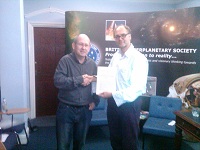
The BIS and Stapledon already have a long history together. On the 9th of October 1948 Stapledon gave a wonderful lecture to members of the society at the invitation of Arthur C.Clarke. It took place at St.Martin’s School, 107 Charing Cross Road, London. The BIS advert read: “In his opening lecture Dr.Stapledon will discuss the profound ethical, philosophical and religious questions which will undoubtedly arise from interplanetary exploration, the possibility of finding intelligent life on other worlds, colonization of planets, interstellar communication, and the possibility of telepathic communication”. Stapledon wrote many books in his life, including Odd John, Sirius, Worlds of Wonder, Darkness and Light. But it is for Last and First Men (1930) and Star Maker (1937) that he is most famous. From these incredible books sprang a range of ideas such as planetary terraforming, genetic engineering, human evolution, transcendence, Dyson Spheres, interplanetary genocide, and the cosmic mind, to name just a few. Arguably the daring works of Stapledon are as important an influence on our culture as the works of William Shakespeare, and yet Stapledon is not very well known throughout the world.
Image (top): Olaf Stapledon. The second image is of Jason Shenai, a Stapledon relative, accepting a gift from the British Interplanetary Society as presented by Stephen Baxter. Credit: Kelvin Long.
Consciousness and Convergence
To discuss his work some Stapledon thinkers came together on this special day. Kelvin Long (co-Chairman) discussed the concept of “universal mentality” and asked if it was at least credible. He pointed to possible physical limitations in the human brain due to the way neurons and axons were ‘wired’ and said this had been foreseen in Stapledon’s literature. Long argued that to become more intelligent we would converge further with technology, Homo Sapiens becoming Homo Electronicus, as Clarke had called it. Long said this would bring about a coupling to the extent that minds could join and the idea of a group mentality or cosmic union would become feasible. He discussed our own self-awareness that we are conscious and indeed aware of each other. He referred to work by the physicist Freeman Dyson who had argued in his book Disturbing the Universe that mind does appear to play a role in reality. This includes the observer dependence in the quantum description of reality and the potential for all our observations being represented by the analogue of a quantum wave function. He discussed the Hawking-Hartle wave function of the Universe. Long also talked about the various cosmic co-incidences in the universe, such as the many physical constants just being right for life, or even intelligent life to form, so-called anthropic reasoning. He ended with a discussion on the laws of physics and in particular the special theory of relativity, which demands the constancy of the speed of light. He said this would place fundamental limitations on any universal mentality or indeed the Star Maker, on how ‘it’ communicates with those that inhabit the universe. He said this law would have to be broken in order for the ‘Supreme Moment of the Cosmos’ (a term from Star Maker) to ever be feasible for all of the inhabitants of the universe simultaneously.
Andy Sawyer had visited from the Science & Science Fiction Library Special Collections and Archive of the University of Liverpool. He spoke about “The Future and Stapledon’s Visions” and quoted from Last and First Men directly: “The romance of the far future, then, is the attempt to see the human race in its cosmic setting, and to mould our hearts to entertain new values”. He talked about many of the books and ideas that had influenced Stapledon’s work in some way, such as The March of Intellect (1829) which depicted fantastic modes of transport such as balloons and steam transport. He referred to George Griffith’s images from The Angel of the Revolution (1893) and Olga Romanoff (1894). Charles Green had even set a major long distance record in a balloon by flying a distance of 480 miles, a record not broken until 1907. These sorts of developments would have found their way into Stapledon’s perspective on the world. Sawyer said that Stapledon showed that the idea of flight was linked to that of change. The culture of the First Men’s 24th-century World-State is based, technologically and spiritually, on aircraft. Sawyer impressed the audience by putting up a time chart that Stapledon had constructed for Last and First Men, complete with colored lines. Later, Andy would talk about the good work being done by the University of Liverpool Science Fiction Foundation, founded in 1971 and supporting 30,000 books and magazines in the fields of science fiction and related genres. The collection includes the Olaf Stapledon Archive and the Eric Frank Russell and John Wyndham Archives.
Patrick Parrinder, a former Professor of English at the School of English & American Literature, University of Reading, discussed “The Earth is My Footstool: Wells, Stapledon, and the Idea of the Post-Human”. Parrinder referred to Stapledon’s early life in Egypt and suggested that his mythical avatar was the Sphinx. His fiction was the portal to the mysteries of cosmic existence, unraveling the Sphinx’s riddle of the transformations of the human animal, and it does this with a Sphinx-like abstraction from domestic emotions and personal relationships. He said the Eighteenth Men whose outlook dominates in Last and First Men and Last Men in London are, we are told, both human and animal in nature, like the old Egyptian deities with animal heads. He said that later H.G.Wells had also taken the Sphinx as his symbol in a substantial work of fiction, The Time Machine, which stands alone among Wells’ novels for its unremittingly bleak view of human destiny. Stapledon apparently claimed not to have read this book when he wrote Last and First Men. The talk covered so much ground and in such a scholarly way it is impossible to do it justice in this brief article and the above is merely a snapshot of what was covered.
Kelvin Long presented a paper on behalf of Greg Matloff, Emeritus Associate Professor and Adjunct Associate Professor, New York City College of Technology. This talk was one of the most fascinating presentations of the day and was on the subject of “Star Consciousness: An Alternative to Dark Matter”. Matloff had looked for an alternative to explain the dark matter problem and proposed the hypothesis that stars may be conscious, as an exercise in philosophical speculation in the spirit of Stapledon’s literature. He pointed to models of stellar radiation pressure and stellar winds which failed to account for the anomalous stellar velocities and instead proposed psychokinetic action, a principle claimed to be now demonstrated in quantum fluctuations. He also pointed towards Parenago’s discontinuity to explain how stars can adjust their galactic velocity. Cool, red stars were said to move around the galaxy faster than hot, blue stars. Molecules were also said to be rare or non-existent in the spectra of hot, blue stars. If stars were ever found to be conscious, this would present a problem for the Search for Extraterrestrial Intelligence (SETI) in terms of how we communicate with them. The presentation ended by saying that Descartes argued in favor of a separation of consciousness from the physical world but possibly, the entire universe may be conscious.
Technology and Paradox
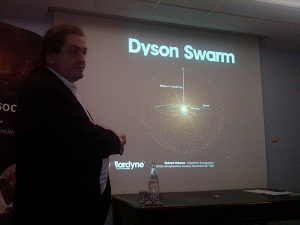
After lunch Richard Osborne (co-Chairman) and a member of the BIS Council, spoke about “Dyson Spheres”. These are hypothesized artificial habitats built around a star by a civilization with sufficiently advanced technology, able to capture as much as possible of the power output of the star. Osborne said the idea had originated in 1927 from J.D.Bernal but Stapledon had included a reference to the concept in his book Star Maker: “Not only was every solar system now surrounded by a gauze of light traps, which focused the escaping solar energy for intelligent use, so that the whole galaxy was dimmed, but many stars that were not suited to be suns were disintegrated, and rifled of their prodigious stores of sub-atomic energy.” The physicist Freeman Dyson, after whom the concept was named, worked on the idea in some detail in 1960, in a paper published in Science titled “Search for Artificial Stellar Sources of Infrared Radiation”. Osborne described the various other spin-off concepts that had evolved from the original idea, including Dyson Swarms, Dyson Statite Bubbles and Dyson Shells. Other astroengineering megastructure concepts were described including Matrioshka Brains, Shkadov Thrusters, Klemplerer Rosettes, Alderson Disks and of course Ringworlds, now made famous by Larry Niven’s excellent novel of the same name.
Image: Richard Osborne presenting his work on Dyson Spheres. Credit: Kelvin Long.
Stephen Baxter then took the stage for an interesting discussion on “Where was Everybody? Olaf Stapledon & The Fermi Paradox”. He opened with a quote from Stapledon’s ‘Interplanetary Man’ lecture: “If, by one means or another, man does succeed in communicating with intelligent races in remote worlds, then the right aim will be to enter into mutual understanding and appreciation with them, for mutual enrichment and the further expression of the spirit. One can imagine some sort of cosmical community of worlds”. Baxter said that Stapledon had communicated with both H.G. Wells and Arthur C. Clarke although it doesn’t appear that H.G. Wells had any influence on the work of Stapledon’s two key publications, Last and First Men and Star Maker. He described the Fermi paradox first presented by the Italian born physicist Enrico Fermi in the summer of 1950 and pointed out it is unlikely Stapledon heard of the paradox, as he sadly passed away in September of that same year. Baxter said that the Fermi Paradox had turned out to be a good organizing principle and a great plot generator for science fiction whilst also being a deepening paradox. The Search for Extraterrestrial Intelligence had seen the discovery of exotic biologies on Earth, habitable realms in the solar system, the discovery of many exoplanets, the invention of multiple contact strategies, and yet there had been 50 years of silence. He said that most of the Fermi Paradox solutions tended to fall into one of three categories; ETI is here; ETI exists but has not communicated; ETI does not exist. Baxter said that both Fermi and Stapledon were cosmic thinkers but the visions of Stapledon were still not found to be consistent with the paradox that Fermi had seen that one afternoon in 1950.
Finally, Ian Crawford, a Reader in Planetary Science & Astrobiology from Birkbeck College, London, gave a masterful exposition on “Stapledon’s Interplanetary Man: A ‘Commonwealth of Worlds’ & The Ultimate Purpose of Space Colonization”. Crawford described the three main futures that Stapledon had defined; speedy (self-inflicted) annihilation, creation of a world-wide tyranny (implied stagnation), and the founding of a new kind of world where every body works for the good of the common human enterprise. But he said there are other possibilities Stapledon had not considered, such as the creation of tyrannies that may not result in technological stagnation and may still be compatible with space exploration. He said space exploration can still proceed without the prior creation of social or political utopias and pointed to Project Apollo as an example of how nation state competition had still led to progress in space.
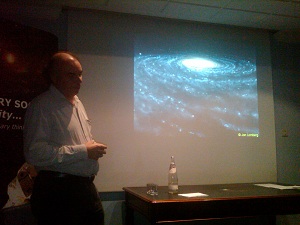
Crawford also said that Stapledon appeared to downplay the economic and scientific motivations for space exploration, yet the former is important for maximizing human well-being and the latter is a key component of human intellectual development. He spoke about the race we appear to be in now, between cosmic fulfillment and cosmic death. A situation echoed by our current dilemma, to become a spacefaring civilization or face stagnation and decay. Crawford made the important point that in thinking about space exploration we had to justify why we want another planet and what we are going to do with it, given that we already have a planet and have not treated the Earth very well. He asked whether before we consider this question, we should consider what man ought to do first with himself. Crawford ended by pointing towards the September 2011 publication of “The Global Exploration Roadmap” by the International Space Exploration Coordination Group and said that if Stapledon were here today he would have approved of this as a sign of positive progress that humanity is starting to work together as a global community in the exploration of space.
Image: Ian Crawford discussing the possibilities in Stapledon’s fictional futures. Credit: Kelvin Long.
Kelvin Long rounded up the day with two quotes that he thought Stapledon would have approved of. The first was from Carl Sagan: “The Universe is not required to be in harmony with human ambitions”. The second was from William Hartmann: “Space exploration must be carried out in a way so as to reduce, not aggravate, tensions in human society”. In a foreword to an Orion Books reissue of Star Maker, science fiction writer Brian Aldiss said of Stapledon: “He is too challenging for comfort. The scientifically minded mistrust the reverence in the work; the religious shrink from the idea of a creator who neither loves nor has need of love from his creations”. It is well known that Arthur C. Clarke was influenced by Stapledon’s Last and First Men and he said: “No other book had a greater influence on my life…[It] and its successor Star Marker are the twin summits of [Stapledon’s] literary career”. Clarke’s work had embraced hard science fiction but with an almost mystical tone to some of his stories. Long speculated that perhaps this is a good place to be for a writer, at the boundary between what we know to be true and what we can only speculate may be possible, the boundary between reality and imagination. As C.S.Lewis once said of Stapledon, he was a corking good writer. Now is the time for others to discover the literature of Olaf Stapledon, and the imagination that sprang from the dreams within his grand philosophy. It is fitting and proper to end an article on Olaf Stapledon by giving him the final word:
“Is it credible that our world should have two futures? I have seen them. Two entirely distinct futures lie before mankind, one dark, one bright; one the defeat of all man’s hopes, the betrayal of all his ideals, the other their hard-won triumph.”
Dr. William Olaf Stapledon, Darkness and the Light (1942)
A full article on the BIS symposium will be submitted to the society’s magazine Spaceflight. The papers from the symposium will appear in a special issue of the Journal of the British Interplanetary Society. Stapledon’s work, especially Star Maker and Last and First Men, remains widely available.

